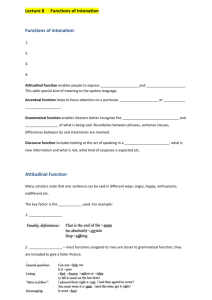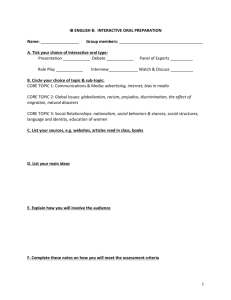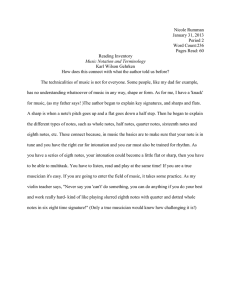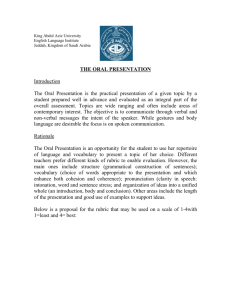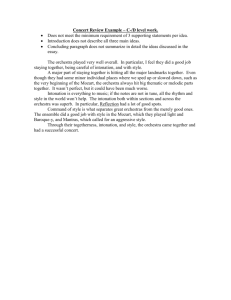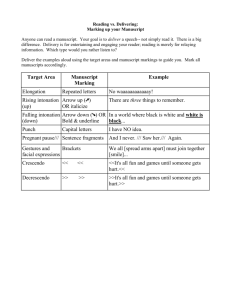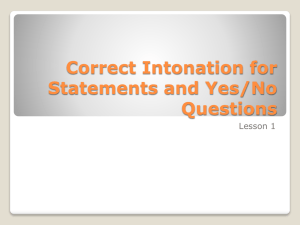LECTURE_14_Functions of intonation
advertisement
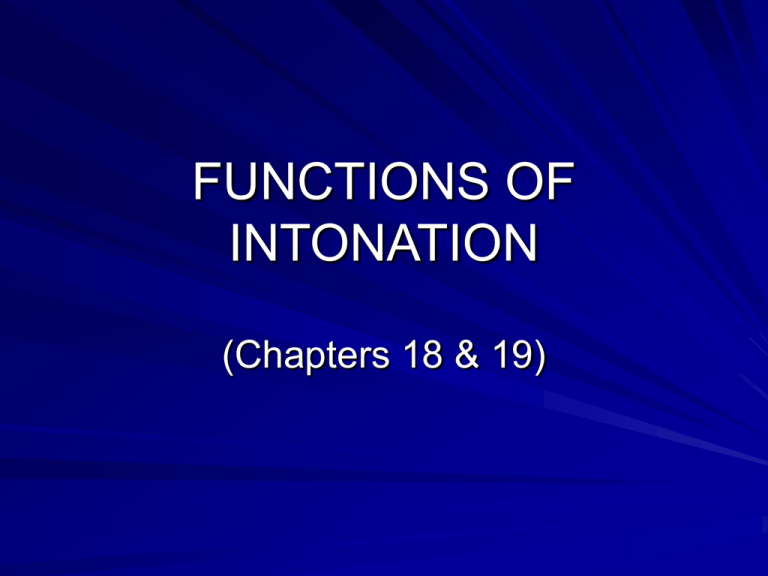
FUNCTIONS OF INTONATION (Chapters 18 & 19) What would an utterance lose if intonation were omitted? Every syllable said on the same level pitch No pauses No changes in speed and loudness Such would be speech produced by the “mechanical speech device” Therefore, intonation makes it easier for the listener to understand the meaning a speaker is trying to convey 4 main functions of intonation: Attitudinal function Accentual function Grammatical function Discourse function Attitudinal function Intonation enables the speaker to express emotions and attitudes which adds a special meaning to spoken language as a difference from its written counterpart Accentual function Intonation helps to produce the effect of prominence on syllables that should be perceived as stressed while tonic stress on a particular syllable marks the word as the most important in the tone-unit. Grammatical function The listener better recognizes grammar and what is being said by using the information contained in intonation: e.g. placement of boundaries between phrases, clauses and sentences, difference between questions and statements, use of grammatical subordination, etc. Discourse function Intonation can signal to the listener what is to be taken as “new information” within the act of speaking, when the speaker is indicating a contrast or link with the material from previous tone-units and it can also make the listener feel what kind of response is expected Attitudinal and discourse functions Overlap in certain ways The other 3 functions can hardly be disentangled as: E.g. placement of tonic stress is closely linked to the presentation of “new” information; Question/statement distinction is equally important in grammar and discourse Common to accentual, grammatical and discourse functions: is indication by means of intonation of the relationship between a linguistic element and the context in which it occurs Attitudinal function The same sentence can be said in different ways labelled as “happy”, “angry”, “grateful”, etc. Intonation differs from language to language Often pointed out that if a foreign learner does not learn proper intonation he/she may unintentionally give offence How to analyse the attitudinal function? Try saying one sentence with different intonation patterns Ask a group of listeners what attitudes they think have been expressed Ask them to choose among a small number of adjectives or labels Ask a lot of speakers to say a list of sentences in different ways according to labels provided by the analyst A more useful and realistic approach: To study recordings of different speakers´ natural, spontaneous speech and on this basis make generalisations about attitudes and intonation Material chosen should be neutral from the emotional point of view, i.e. pure questions or utterances qualified by the use of specific vocabulary indicating their purpose should not be considered Components of intonation: Sequential Prosodic paralinguistic Sequential component Components never occur simultaneously They are: pre-head, head, tonic syllable, tail Pauses Tone-unit boundaries Prosodic component - Characteristics of speech that are constantly present while the speech is going on: Width of pitch range Key Loudness Speed Voice quality (rhythmicality) Paralinguistic component Facial expressions, gestures, body language Vocal effects: laughs, sobs, ... Effects relevant to the act of speaking but not proper components of speech Tones conveying meanings: Fall: finality, definiteness - Stop talking! I´m absolutely certain! That is the end of news! Rise: - Functions nearer to grammatical than to attitudinal: e.g. general questions: Can you help me?; listing: red, brown and black; “more to follow ...”: I phoned them right a way; encouraging: It won´t hurt. Fall-rise: - uncertainty, doubt: You may be right. - Requesting: Can I buy it? Rise-fall: - surprise, being impressed: You were first. Generalisations of the kind are: Very broad Foreign learners do not easily acquire intonation only through studying patterns Still, wider pitch range = excited or enthusiastic speaking; slower speed = typical of the speech of tired or bored person Useful but difficult to teach or learn if not speaking or listening to native speakers; still, building up awareness and sensitivity for ways native speakers use intonation has been our aim Accentual function Derived from the word “accent” = stress Placement of stress is determined by intonation Although stress has been presented as independent of and placing of stress prior to the choice of intonation, placement of the tonic stress within the tone-unit can be regarded as part of intonation. Location of the tonic syllable Of great linguistic importance The most common position – on the last lexical word of the tone-unit But, for contrastive purposes any word can become the bearer of the tonic syllable Thus, the placement of the tonic syllable represents the focus of the information Examples of contrast / emphasis I want to know where he´s travelling to I want to know where he´s travelling from She was wearing a ´red dress It was ´very boring It was very boring You ´mustn´t ´talk so loudly You mustn´t talk so loudly Tonic syllable earlier in the toneunit, not for reasons of empasis I have plans to leave I have plans to leave The rule?? Here´s that book you asked me to bring I´ve got to take the dog for a walk I´ve got to take the dog to the vet Grammatical function Sentences which when written are ambiguous, and ambiguity can only be removed by different intonation: e.g. Those who sold quickly made a profit (A profit was made by those who sold quickly) Those who sold quickly made a profit (A profit was quickly made by those who sold) Link between tone-unit and units of grammar Tone-unit boundaries usually occur at boundaries between grammatical units of higher order than words (at sentence boundary: e.g. I won´t have any tea I don´t like it) At phrase and clause boundaries: e.g. In France where farms tend to be smaller the subsidies are more im portant Restrictive vs. non-restrictive relative clause The Conservatives who like the proposal are pleased (only some of them) The Conservatives, who like the proposal, are pleased (all of them) Grammatical significance of tone on the tonic syllable : rise with questions, choice between falling/rising tone can differentiate statement and question of the same for (e.g. Why do you want to buy it? The price is going up) Falling tone with questions Wh-questions: where did you park the car Question tags: They are coming on Tuesday aren´t they (the example shows overlapping between attitudinal and grammatical function) Discourse function An attempt to look at larger contexts in which sentences occur (R., p.198); sentences form part of a larger act of conversational interaction between speakers They make references to the shared knowledge Intonation and discourse Intonation focuses the listener´s attention (by placing tonic stress on the appropriate syllable) on important aspects of the message Intonation regulates conversational behaviour Falling tone is used to indicate new information Rising toneindicates “shared” or “given” information (R., p.199) Intonational subordination A case when we signal that a particular tone-unit is of comparatively low importance and give greater importance to adjacent tone-units. (R., p.200) Regulation of conversational behaviour It refers to what the speaker is doing in speaking: questioning, challenging, advising, encouraging, disapproving, etc. It signals when one has finished speaking and whether another person is expected to speak (regulates turn-taking), a particular type of response, etc.
